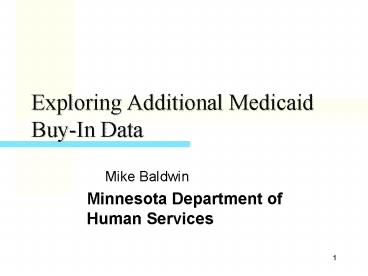Exploring Additional Medicaid BuyIn Data - PowerPoint PPT Presentation
1 / 14
Title:
Exploring Additional Medicaid BuyIn Data
Description:
... or in an 'overlapping' fashion (the possibility of multiple ... Enrollment Trends. Medicaid Utilization. 13. Data Analysis and Policy Decision Making ... – PowerPoint PPT presentation
Number of Views:36
Avg rating:3.0/5.0
Title: Exploring Additional Medicaid BuyIn Data
1
Exploring Additional Medicaid Buy-In Data
- Mike Baldwin
- Minnesota Department of Human Services
2
Session Topics
- Standardizing Disability Type Classification
Using Medicaid Claims Data For State-to-State
Comparisons - Data Analysis and Policy Decision-Making
3
Standardizing Disability Type Classification
- Developed by Robert Keith, Muskie School of
Public Service - Uses Medicaid claims data (with an emphasis on
ICD-9 diagnosis codes) to identify broad
disability types - Physical Disability
- Mental Illness
- Mental Retardation
- Though still in a development and testing phase,
it is hoped that this concept will allow
meaningful comparisons between states
4
Standardizing Disability Type Classification
- Ideally, the exclusive use of Medicaid claims
data will allow states to approximate each
others logic closely - The logic consists of three levels of Medicaid
claims data searches. The logic can be applied
hierarchically (one disability type per person)
or in an overlapping fashion (the possibility
of multiple disability types per person)
5
Standardizing Disability Type Classifications
- Level I Search Criteria
- Mental illness and physical disabilities ICD-9
diagnosis codes that indicate a per se disabling
condition from the U.S. Health and Human
Services report, Private Payers Serving
Individuals with Disabilities and Chronic
Conditions - For mental retardation, ICD-9 diagnosis codes for
moderate, severe, or profound mental retardation
6
Standardizing Disability Type Classifications
Preliminary comparison of hierarchical disability
type classification of adult Medicaid disabled
population between Minnesota and Maine using
Level I search criteria
7
Standardizing Disability Type Classifications
- Level II Search Criteria
- Mental Illness Antipsychotic medications
waivers and categories of service for persons
with mental illness diagnoses of substance abuse - Physical Disabilities Waivers and categories of
service for persons with physical disabilities - Mental Retardation Waivers and categories of
service for persons with mental retardation and
related conditions
8
Standardizing Disability Type Classifications
Preliminary comparison of hierarchical disability
type classification of adult Medicaid disabled
population between Minnesota and Maine using
Level II search criteria
9
Standardizing Disability Type Classifications
- Level III Search Criteria
- Mental Illness any ICD-9 diagnosis code for
mental illness (except sexual deviance and
non-dependent abuse of drugs) - Physical Disabilities ICD-9 diagnosis codes that
indicate an activity limiting condition from
the U.S. Health and Human Services report,
Private Payers Serving Individuals with
Disabilities and Chronic Conditions - Mental Retardation diagnosis of unspecified or
mild mental retardation, or a diagnosis of Downs
Syndrome
10
Standardizing Disability Type Classifications
Preliminary comparison of hierarchical disability
type classification of adult Medicaid disabled
population between Minnesota and Maine using
Level III search criteria
11
Standardizing Disability Type Classifications
Preliminary comparison of overall hierarchical
disability type classification of adult Medicaid
disabled population between Minnesota and Maine
12
Data Analysis and Policy Decision Making
- Empirical data analysis helps in the process of
developing policy and measuring the effects of
policy after it has been implemented it can be
useful to project and evaluate things like - Costs
- Enrollment Trends
- Medicaid Utilization
13
Data Analysis and Policy Decision Making
Example Considering the earnings levels of
Medicaid Buy-In enrollees with concurrent Day
Training and Habilitation service agreements in
advance of a policy proposal requiring at least
65 average monthly earnings to remain on the
program to project how many from this group might
lose eligibility
14
Sources
- Ozminkowski, Ronald J. et al. Private Payers
Serving Individuals with Disabilities and Chronic
Conditions. Washington D.C. The Medstat Group,
under contract with The U.S. Department of Health
and Human Services 2000. 12
January 2004. lthttp//www.aspe.hhs.gov/daltcp/rep
orts/privpay.htmTocgt































